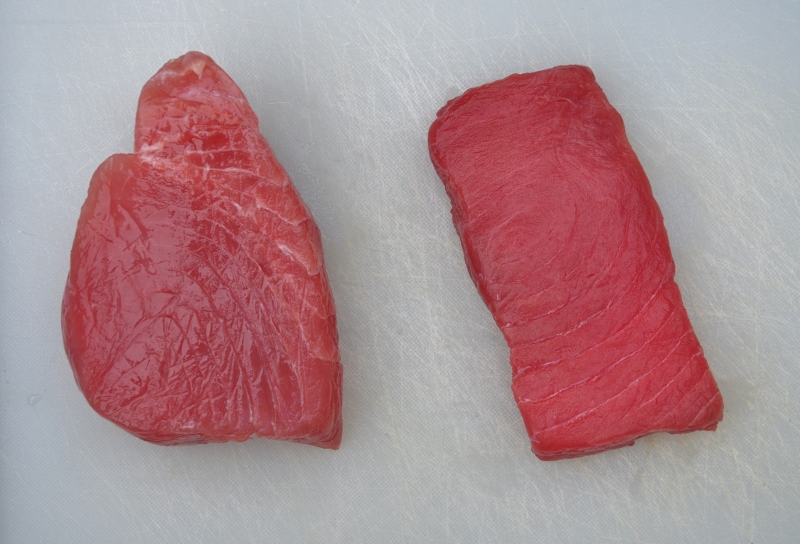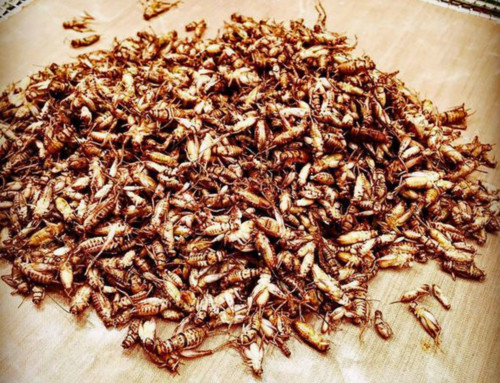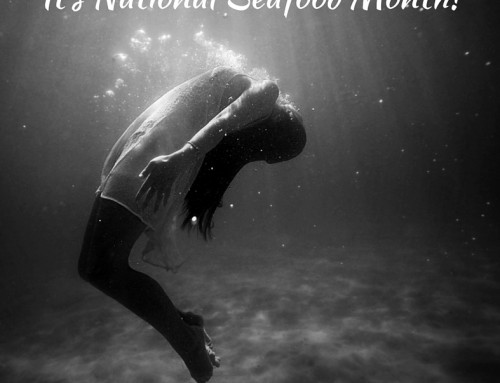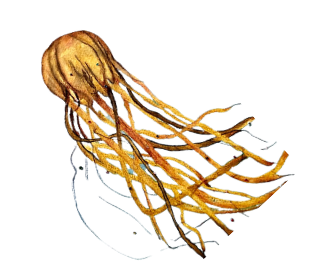(In Part I Tuna: explored and exposed, I explored eating tuna from a consumer perspective. In Part II, I define the differences between Carbon Monoxide gassed tuna and fresh tuna. In Part III, I’ll look to Japan, the world’s primary and principle tuna market.)
Do you think you would be able to tell if the tuna on your plate was Carbon Monoxide (CO) tuna or fresh tuna?
Maybe if you saw CO tuna next to a piece of yellowfin tuna in a display case you would know.
What about these two pieces of tuna? Can you tell?
The piece on the left is yellowfin tuna, and the piece on the right is CO tuna, labeled “Sashimi,” in the display case.
Which piece would you buy? The yellowfin tuna sells for $19.99 per pound. The “Sashimi” tuna, $4.99 per piece. They are different in weight by a few ounces.
A recent story on NPRs blog, The Salt, shows just how difficult it is to tell one species of seafood from another. Even professional chefs had a hard time deciding wild salmon from farmed, tilapia from snapper, according to the report. While that article addressed seafood fraud, a common practice in the seafood industry according to Oceana, (and I have my own personal experience too), the study showed how hard it is even for the trained eye to tell the difference between similar species of seafood.
Does it matter if you can tell the difference between CO tuna and fresh tuna?
- If you care about what you’re eating, then it should matter to you.
- If you care about the value of your dollar, it should matter to you.
- If you care about your health, it should matter.
First, let me define how tuna is graded and then, what CO tuna means.
In a nutshell, once tuna is caught, it is graded. Grading tuna is a highly subjective process. It is based on size, species, when it was caught, texture, core temperature, color and fat. This post will discuss the color and health issue of tuna.
A general rule about tuna: the higher the fat content of the tuna and brighter the flesh, the higher the price of the tuna.
This grading process begins by cutting a sample, or section, from the tail of the tuna. For instance, a premium piece of tuna will be brilliant red, translucent, firm, and will melt on your tongue.
Once the tuna is graded, sold, then processed, like any fish, the flesh begins to deteriorate from oxidation, unless it is frozen. With tuna, that means the flesh will begin to turn brown and eventually grey, the muscle will break down, get soft and mushy. It’s imperative fresh tuna is kept wrapped to reduce the oxidation process, sold quickly, and consumed immediately, or frozen, or processed to preserve.
This is where the Carbon Monoxide (CO) process comes into the equation.
CO is a tasteless, odorless gas. It is toxic in animals and humans in high doses.
Tuna suppliers and processors use CO to reduce the oxidation process and to “preserve” the fish. Using CO will turn an inexpensive piece of tuna, or a lesser graded tuna, into a sashimi cut of tuna.
Remember, tuna’s color and fat (overall) determine price.
You can see the issues with using CO to “preserve” the color and quality of tuna, right?Why the CO practice bothers me (and maybe you too), is it allows a less expensive species to be sold for more than it’s worth. Some CO tuna I’ve eaten has little flavor, which could be explained because it’s an inferior fish. The CO process doesn’t add fat (read flavor), just color. The process mask’s spoilage, one of the reasons processors are permitted to use CO, which is a bigger issue than the economic reason.
When you see a super bright pinkish-red tuna in the display case, (or if you’re working in a restaurant) chances are it is CO tuna and should be labeled as such. But it is probably labeled “sashimi.” Because it is not required to be labeled as CO. Despite its controversial nature, the CO process is legal in the US. The process is banned in Japan, Singapore, and the European Union.
If you like to eat tuna, you should know what species to buy and that if your tuna is CO tuna or not.
What kind of tuna should you buy?
If you decide to buy “sashimi” tuna, follow the same guidelines you use when you buy fresh fish. Don’t buy if the fish smells, is slimy, has freezer burn, or the package is bulging.
 A few acceptable sources and species of fresh tuna, according to Seafood Watch, are albacore tuna caught in US & Canadian Pacific, and bigeye tuna from US Atlantic. For more information, download the Seafood Watch App for iPad or iPhone, or if you’re a chef, download and print a pocket guide for your region for your kitchen and wait staff.
A few acceptable sources and species of fresh tuna, according to Seafood Watch, are albacore tuna caught in US & Canadian Pacific, and bigeye tuna from US Atlantic. For more information, download the Seafood Watch App for iPad or iPhone, or if you’re a chef, download and print a pocket guide for your region for your kitchen and wait staff.
Check back next week for Tuna: explored and exposed Part III, a case study of the tuna market in Japan, the world’s primary and principle tuna market. Or sign up to have my posts delivered to your inbox.
Resources:








Dear Maureen! Why is part 1 unavailable?